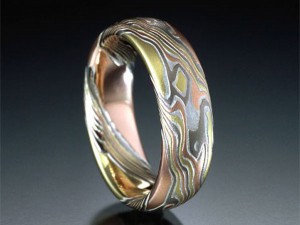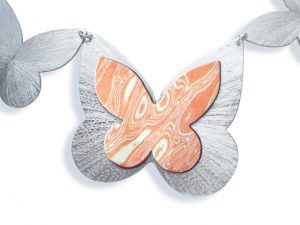If you are wondering what Mokume-Gane is or how it is made, we’ve got you covered with this guide all about the historic prosses behind the beautiful technique.
The History of Mokume-Gane
Mokume-Gane is a decorative metal working technique, originating from 17th century Japan, when it was used to decorate samurai swords. The term translates to ‘wood grain metal’ and is still used today by a handful of talented individuals.
The method itself has evolved over time but remains incredibly labour intensive and something that few craftsmen are ambitious enough to attempt. (Fortunately for the less motivated amongst us, Mokume-Gane Sheet is now available to buy pre-made)
Between the 1600 and 1800s the role of the samurai sword changed from that of a functional weapon to one of social status and wealth. As with many decorative objects, the more elaborate the ornament, the higher the perceived value and this became very much the case with the samurai sword towards the end of this period. Mokume-Gane was one of the many intricate metal working techniques developed by Japanese craftsmen for this very purpose.
How is Mokume-Gane made?
In its basic form Mokume-Gane is made up of layers of different coloured metals which are fused together using only heat to form a billet (stack of fused metal). This billet is then forged, carved and rolled to reduce the thickness into workable material but also to achieve the inimitable patterns which are indicative of this technique.
Each piece created is unique and quite beautiful and is truly a work of art even before it is created into a piece of jewellery. To this end much of the Mokume-Gane jewellery you will see is quite simple in design so as not to overshadow the beauty of the metal itself.
When metal is simply fused together as opposed to fully joined by soldering, there is always a risk that it may come apart again under pressure or when subjected to considerable force. An integral part of the Mokume-Gane technique relies upon the repeated application of force so when traditionally practised it was an extremely difficult procedure to master.
However newer more failsafe methods have been developed and today up to 30 layers of metal can be fused together in an electric kiln where the heat, pressure and atmosphere can be carefully controlled. This ensures the metal is perfectly fused rather than melted together resulting in a stronger bond.
The metal can then be carved to create the patterns and forged to flatten the surface over and over again until the desired finish is achieved which is still labour intensive but much less likely to separate during forging.
What is Mokume-Gane made from?
The range of metals used in Mokume-Gane can vary. It is an expensive process so most examples tend to be fabricated in gold, platinum and silver (generally 18k gold is used to achieve the best colour contrast). Conversely there are also cheaper versions available using copper, palladium, titanium, brass and iron which aesthetically are equally beautiful whilst commanding a much lower price tag.
The inclusion of rose gold is a popular at the moment following the global trend for all things pink in jewellery and works particularly well when coupled with white metal. Regardless of metal, it is a great choice for a special occasion piece which is just a little bit out of the ordinary.
Now you know the history, metals and techniques of Mokume-Gane! Explore the pre-made Mokume-Gane sheet metal on offer at Cooksongold.com to start making your own Mokume-Gane jewellery.

Cooksongold


